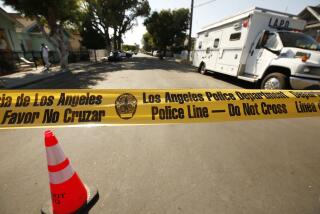Inaction Has Left the Capitol Vulnerable to Terrorism for Years
- Share via
SACRAMENTO — In the state Capitol garage, a postal truck rolls to a loading dock and dumps a large stack of mail. Twice a day. Right under the governor’s office.
Where, sources say, a bomb could be detonated that not only would demolish the governor’s office, but conceivably bring down the entire six-story Capitol, under a crumbling 20-story dome.
“It wouldn’t be hard,” says a Capitol official. A bomb could be slipped into the U.S. postal truck and, once dumped on the dock, detonated electronically from across the street.
The mail is delivered on trays stacked in a large rack, which is wheeled off the truck onto the dock. There it sits a short while before being moved to a nearby X-ray machine for inspection.
So far, nothing’s happened--no big bombs exploded or detected, although a crude letter bomb did make it to a Capitol office a few years ago. The intended recipient noticed wires in the envelope and called Capitol cops.
Why report this vulnerability now and, presumably, tip off terrorists? Because some important people in the Capitol, while insisting on anonymity, want to get the word out. It has been an open secret for decades anyway. They hope to generate pressure on the Legislature’s Joint Rules Committee to substantially tighten Capitol security.
Mail collections probably should be moved to some building far from the Capitol, they say. The mail could be X-rayed there, then delivered to the Capitol.
Seems simple. But, as we’ve noticed, government does not tend to get motivated until there’s a calamity. And then it usually demands more of the public than itself.
Examples are everywhere, particularly at airports. At LAX, private vehicles are banned from the loop around the terminals. Short-term parking is forbidden. Curb-side baggage checks are out. Tweezers, nail clippers and pencil sharpeners are being seized. Much of this is typical overreaction--action for the sake of acting.
It’s difficult to imagine any group of passengers this week allowing some hijacker to hold a flight attendant hostage with a nail clip. Or a plastic knife, for that matter.
The public will tolerate some inconveniences--banning small carry-on items (briefcases, laptops) is not one of them--but the government also should inconvenience itself. When is it going to take over pre-board screening of passengers? Post armed guards aboard every flight? Arm pilots and seal their cockpit doors?
Pencil sharpeners!
At the California Capitol, they’ve closed down four of the six entry doors. Haven’t got enough personnel to watch all six, they say--they being the Highway Patrol and legislative sergeants-at-arms, who guard the building. For the first time, all IDs are being checked and bags are being searched.
There are no metal detectors except at the legislative galleries. But there’s talk of installing them at all entry doors. If operated smoothly--using the White House as a model, rather than the airports--this is a public inconvenience that probably could be tolerated. It does seem needed, given the 1 million people who stroll through the Capitol every year.
There have been several security upgrades at the Capitol in recent years: All windows now are plastic-coated to prevent shattering and to change a bullet’s direction. Surveillance cameras are monitored 24 hours. The two garage entrances have gates with armed guards and ugly steel traps that can spring from the pavement.
But a truck that says “Postal Service” can tote in a bomb.
Senate Chief Sergeant-at-arms Tony Beard has worked in Capitol security for 34 years--and his father and grandfather before him. He’s not the original tipster on the garage exposure, but confirmed it.
Indeed, the Capitol has been sitting on this vulnerability so long that Beard 18 years ago first recommended the mail be collected “off campus.”
It could cost the state $1 million annually, he estimates. But that’s cheaper and more convenient than rebuilding the Capitol.
Beard also has been lobbying for a fence around the Capitol--something to slow down a speeding truck, such as the tractor-trailer rig that rammed the south portico in January, exploding into a towering sheet of flames. There’s already $5 million and plans for a granite-and-wrought iron barrier.
But there’s also opposition and inertia.
Senate Leader John Burton (D-San Francisco) says he’d consider planters, but not a fence.
Assemblyman Dennis Cardoza (D-Merced), chairman of the Joint Rules Committee, is anxious to build some perimeter protection. “This Capitol is one of the major targets on the West Coast,” he says. “It’s high profile and gets significant threats.”
Then his committee had better move the mail drop.
More to Read
Sign up for Essential California
The most important California stories and recommendations in your inbox every morning.
You may occasionally receive promotional content from the Los Angeles Times.














